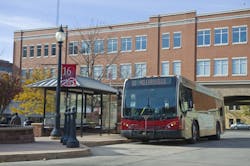In 2013, longtime Berks Area Regional Transportation Authority (BARTA) Executive Director Dennis Louwerse died, leaving the Reading, Pennsylvania-based agency in need of new leadership. Dave Kilmer, executive director of Red Rose Transit in Lancaster, Pennsylvania, had spent two different stints at BARTA, so the board approached him for help while trying to find a permanent leader. The appointment was set to last six months, but during Kilmer’s term, the BARTA board started looking at its long-term options, so one of the items discussed was merging BARTA and Red Rose into one agency.
“We knew that merging transit agencies is something that PennDOT was going to push, so the consensus was let’s do this kind of on our own terms rather than theirs,” Kilmer said. “If that’s the direction they’re pushing for, why not look at doing it ourselves?”
Kilmer said a special committee comprised in April 2014 of three members from each of the transit agencies boards began meeting on a biweekly basis to look at data systems, articles of incorporation, labor contracts and other details. By July it was decided they were moving toward a merger, a new authority was created on Dec. 11, 2014 and on Jan. 1, 2015, the South Central Transit Authority (SCTA) began overseeing transit services in Reading and Lancaster under the guise of a 10-member board split between the two communities.
A Shared Service
Red Rose and BARTA joining forces is part of a larger trend among transit agencies looking to streamline operations and reduce costs while providing better overall service.
On July 1, The Victor Valley Transit Authority (VVTA), in Hesperia, California, took over control of Barstow Area Transit in Barstow, California, which consisted of three city routes and two county routes.
Kevin Kane, executive director of VVTA, said the process began in 2011 after the city of Barstow contacted the agency to run service to Fort Erwin. The federal government discontinued its shuttle service from the fort to Barstow and the city asked VVTA to provide the service. In 2012, the agency began a service from Victorville, California, to Fort Erwin, which is about 80 miles one way.
Kane said while the process was underway to start the service, then-Barstow leaders asked if VVTA would be interested in taking over the city’s transit service.
“They had one employee who oversaw that who was with MV Transportation,” he said. “Under the agreement approved by Caltrans, our contractor — Transdev — took over the service.”
Kane said the planning for the takeover was all done in-house by VVTA, which worked with the city on how it would operate. The two sides reached an agreement in September 2014.
“That was the ring to make the engagement and things were going very well,” Kane said. “But along the way, we felt a little bit of consternation from the city council about it giving up direct authority to a board of directors.” Kane said they decided to give Barstow representation on the board and expanded from five to seven members. They also agreed the board would meet quarterly in Barstow.
There were also concerns from city leaders about giving ownership of the vehicles to VVTA, so Kane said they agreed the city would keep them under the first two years of the contract while the new service is evaluated. The merger process went through without animosity, Kilmer said, and of the 20 members split between the BARTA and Red Rose boards, only one dissented to the merger, who ironically enough was the first to contact Kilmer about merging the systems.
Kilmer said SCTA is still working at melding the staffs of the former agencies, given two different cultures. Meanwhile, it’s also starting to delve deeper into savings by taking advantage of economies of scale. “We went from buying for a 52-bus fleet to a nearly 100-bus fleet, so if we purchase together it creates better economies and better pricing,” he said.
Kilmer said they basically did the whole merger on their own. He asked consultant Barbara Gannon to come and assist a little and when the process first started, the two agencies held a board retreat where Kilmer brought in Mike Tann, his old boss at Hampton Roads Transit, who had gone through a merger there.
“One of the nice things we did the first year is we added service,” Kilman said. “We added Sunday service in Reading and expanded service to new employer areas in Lancaster.”
A Chance to Start Anew
Integrating the services and technology takes time, Kane said, but VVTA recently signed a contract with Aecom to do a comprehensive analysis of the merger to see how service can be improved. Since the takeover, Kane said VVTA has improved on-time performance, but some of them are unattainable.
“It’s interested how they had operated it as city staff,” Kane said. “One thing is they went out and bought new GFI fareboxes, but they didn’t buy the backend, so they were basically dropboxes. We’re replacing those with Odyssey’s so we can finally get the data and reports.”
VVTA uses Avail’s GPS system, which will also be integrated into Barstow’s fleet as well. Cost is an issue with adding all the new equipment.
“We’re not going to rush into it,” Kane said.
VVTA is also eliminating an $8 all-day pass offered by Barstow’s dial-a-ride service as Kane said people were using it as an unlimited taxi service. VVTA was also surprised to find Barstow only kept records of the first names of paratransit customers. Staff had to go through and contact all the paratransit riders in order to find out their complete information.
“The Barstow City Council was questioning if we would really be improving service or able to improve service, so within the first few weeks of the takeover a survey went out to all area riders,” Kane said. “All of the riders saw improvements.”
They will likely rebrand as one agency in the next year or so, Kane said.
Unlike a lot of mergers, BARTA and Red Rose were not rebranded. Both still operate in their communities, but under the authority of the SCTA. Only the office staff was consolidated. The legal framework of merging union staff was much more difficult to merge due to existing 13(c) labor provisions.
“These provisions are 50 years old and were developed back when most of the private transit systems became public in order to protect all the employees from losing their jobs when going from private to public,” Kilmer said. “There’s still those same types of provisions at the state level too, so it just wouldn’t work; we couldn’t get it to work, so we decided just to merge the administrative staff.”
The two agencies also worked to SCTA’s favor, Kilmer said, because there was no confusion with the public about the change.
“The average rider, they didn’t even know anything happened, which is the best thing,” he said.
Kilmer said one of the biggest challenges in merging the agencies was making sure both boards were comfortable with the concept. They had to see it wasn’t the case of one agency trying to take advantage of another due to financial issues.
“A big thing was making sure that there were adequate protections for both systems,” he said. “South Central is now the designated recipeient of the federal funds for both urbanized areas and they continue to be two separate urbanized areas due to how the census is done, so the other protection is that the money coming in has to be spent in each of those areas, so that gave them a lot of comfort.” Looking into Barstow’s service allowed VVTA to make changes to help its current riders as well.
“We only allowed two grocery bags on our buses and they allowed five,” Kane said. “We changed our policy to allow five and it works fine. They also allowed shopping carts as long as they were controlled. We tried it and it worked out.” Kilmer said SCTA was still able to achieve its goals for saving money. Under Pennsylvania’s state Act 89, it provides incentive for transit systems to merge and any resulted savings of the merger would allow local communities to forgo funding in the amount of the savings for up to five years. The local match for the agencies is $780,000 combined, so the local governments save about $4 million over five years, then at the end of the term, SCTA would start seeing the local match return, which Kilmer said would be like a $780,000 “windfall.”
“It was real money we ended up saving,” Kilmer said. “We ended up saving by elimination of some of the duplications of responsibilities, some health care savings, some legal savings, we did some joint procurements and now we’re actually saving a little over $800,000, which is in excess of that goal we had set.”
About the Author
Joe Petrie
Associate Editor
I came to Mass Transit in 2013 after spending seven years on the daily newsbeat in southeastern Wisconsin.
Based in Milwaukee, I worked as a daily newspaper reporter with the Waukesha Freeman from 2006-2011, where I covered education, county and state government. I went on to cover courts for Patch.com, where I was the main courts reporter in the Metro Milwaukee cluster of websites.
I’ve won multiple awards during the course of my career and have covered some of the biggest political events in the past decade and have appeared on national programs.
Having covered local government and social issues, I discovered the importance of transit and the impact it can have on communities when implemented, supported and funded.

